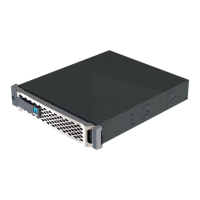2. At the LOADER prompt, access the special drivers specifically designed for system-level diagnostics to
function properly:
boot_diags
3. Select Scan System from the displayed menu to enable running the diagnostics tests.
4. Select Test Memory from the displayed menu.
5. Proceed based on the result of the preceding step:
◦ If the test failed, correct the failure, and then rerun the test.
◦ If the test reported no failures, select Reboot from the menu to reboot the system.
Step 6: Return the failed part to NetApp
Return the failed part to NetApp, as described in the RMA instructions shipped with the kit. See the
Part Return
& Replacements
page for further information.
Replace a PCIe card - AFF A800
To replace a PCIe card, you must disconnect the cables from the cards, remove the SFP
and QSFP modules from the cards before removing the riser, reinstall the riser, and then
reinstall the SFP and QSFP modules before cabling the cards.
• You can use this procedure with all versions of ONTAP supported by your system
• All other components in the system must be functioning properly; if not, you must contact technical support.
Step 1: Shut down the impaired controller
To shut down the impaired controller, you must determine the status of the controller and, if necessary, take
over the controller so that the healthy controller continues to serve data from the impaired controller storage.
About this task
• If you are using NetApp Storage Encryption, you must have reset the MSID using the instructions in the
Returning SEDs to unprotected mode.
•
If you have a SAN system, you must have checked event messages (
cluster kernel-service show)
for impaired controller SCSI blade. The
cluster kernel-service show command displays the node
name, quorum status of that node, availability status of that node, and operational status of that node.
Each SCSI-blade process should be in quorum with the other nodes in the cluster. Any issues must be
resolved before you proceed with the replacement.
• If you have a cluster with more than two nodes, it must be in quorum. If the cluster is not in quorum or a
healthy controller shows false for eligibility and health, you must correct the issue before shutting down the
impaired controller; see
Synchronize a node with the cluster.
Steps
1. If AutoSupport is enabled, suppress automatic case creation by invoking an AutoSupport message:
system node autosupport invoke -node * -type all -message
MAINT=number_of_hours_downh
The following AutoSupport message suppresses automatic case creation for two hours: cluster1:>
system node autosupport invoke -node * -type all -message MAINT=2h
2.
Disable automatic giveback from the console of the healthy controller: storage failover modify
666

